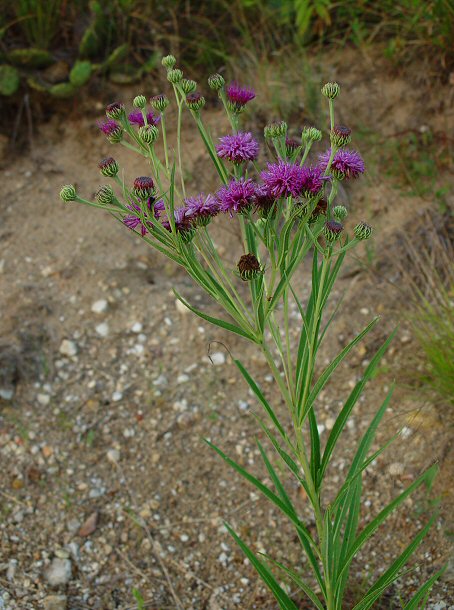Vernonia arkansana DC.
Curlytop Ironweed

Native
CC = 7
CW = 0
MOC = 49
© SRTurner
Vernonia arkansana DC.Curlytop Ironweed | |
 |
Native CC = 7 CW = 0 MOC = 49 |
© SRTurner |
|
Family - Asteraceae/Vernonieae Habit - Perennial forb with a stout, usually short-rhizomatous rootstock. Stems - Ascending to erect, to 1.6 m, glabrous or nearly so, sometimes minutely hairy toward the tip, often appearing somewhat glaucous.
Leaves - Alternate, simple, sessile or short-petiolate. Blades 8-20 cm long, linear to narrowly elliptic-lanceolate, tapered at both ends, the margins sharply toothed or less commonly entire, usually appearing somewhat turned under, both surfaces glabrous to sparsely hairy and appearing dotted with minute, impressed resin glands (these sometimes difficult to observe in fresh material).
Inflorescence - Terminal panicles, irregularly branched.
Heads - Discoid, with 50-120 florets. Involucre 9-16 mm long, hemispherical or somewhat bell-shaped, the bracts 6-14 mm long, all but the outermost ones linear to narrowly lanceolate, long-tapered and somewhat curled to a threadlike, sharply pointed tip, cobwebby-hairy along the margins and sometimes also minutely hairy on the outer surface, green.
Flowers - Ray florets absent. Pappus of an inner series of numerous brownish capillary bristles 6-7 mm long and an outer series of minute scales 0.7-1.0 mm long, persistent at fruiting, with minute, ascending barbs. Corollas 10-12 mm long, reddish purple to purple, relatively deeply lobed, the sinuses between the lobes all similar.
Fruits - Achenes 4-5 mm long. Flowering - July - October. Habitat - Gravel and sand bars along streams, glades, prairies, open woods, rocky slopes, thickets, wet meadows. Origin - Native to the U.S. Lookalikes - Other ironweeds (Vernonia spp.); see below. Other info. - This species is common throughout the southern half of Missouri except for the Bootheel region, where it is rare or absent. Beyond Missouri its range is mostly restricted to three other states: Kansas, Oklahoma, and Arkansas, forming a tight and well-defined distribution. Purebred plants are easily identified by their unique threadlike involucral bracts, which give rise to the common descriptor "curlytop." In practice, the ironweeds cross so promiscuously that huge variability is seen in the shape of the phyllaries of this and other species of Vernonia, and some botanists actually estimate parental percentages by these morphologies. Irrespective of the precise genetic composition, the ironweeds are interesting and colorful native plants and deserve more widespread use in native gardens. They are highly attractive to bees, butterflies, and skippers. Photographs taken at Logan Creek, Reynolds County, MO., 7-17-03 (DETenaglia); also at Shaw Nature Reserve, Franklin County, MO, 7-29-2010 and 8-4-2021, Weldon Spring, St. Charles County, MO, 7-26-2010, and Schuette Prairie, Polk County, MO, 8-5-2024 (SRTurner). |